电子商务导论(双语)所划重点
电子商务导论(双语) chap09
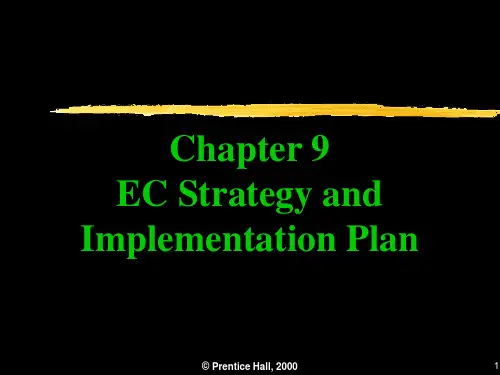
e-care for business partners— dedicated services
providing faster, better information for these important groups
e-care for employees— improving the effectiveness of
Opportunities (O)
Strengths (S)
SO Strategies Generate strategies
here that use strengths to take
advantages of opportunities
Threats (T)
ST Strategies Generate strategies
Describe the key management issues in the strategic planning
© Prentice Hall, 2000
2
IBM’s E-Business’s Strategy
Following four goals:
To lead IBM’s strategy to transform itself into ebusiness and to act as a catalyst to help facilitate that transformation.
Explain the issues involved in EC implementation planning
Experience the role of intelligent agents in the strategic perspective
Characterize how the strategic planning evolves throughout the business cycle
电子商务重点(双语)
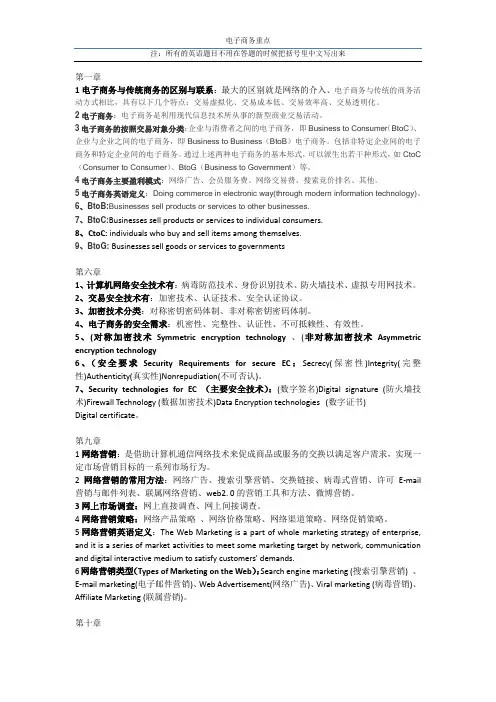
第一章1电子商务与传统商务的区别与联系:最大的区别就是网络的介入、电子商务与传统的商务活动方式相比,具有以下几个特点:交易虚拟化、交易成本低、交易效率高、交易透明化。
2电子商务:电子商务是利用现代信息技术所从事的新型商业交易活动。
3电子商务的按照交易对象分类:企业与消费者之间的电子商务,即Business to Consumer(BtoC)、企业与企业之间的电子商务,即Business to Business(BtoB)电子商务。
包括非特定企业间的电子商务和特定企业间的电子商务。
通过上述两种电子商务的基本形式,可以派生出若干种形式,如CtoC (Consumer to Consumer)、BtoG(Business to Government)等。
4电子商务主要盈利模式:网络广告、会员服务费、网络交易费、搜索竞价排名、其他。
5电子商务英语定义:Doing commerce in electronic way(through modern information technology)。
6、BtoB:Businesses sell products or services to other businesses.7、BtoC:Businesses sell products or services to individual consumers.8、CtoC: individuals who buy and sell items among themselves.9、BtoG: Businesses sell goods or services to governments第六章1、计算机网络安全技术有:病毒防范技术、身份识别技术、防火墙技术、虚拟专用网技术。
2、交易安全技术有:加密技术、认证技术、安全认证协议。
3、加密技术分类:对称密钥密码体制、非对称密钥密码体制。
4、电子商务的安全需求:机密性、完整性、认证性、不可抵赖性、有效性。
电子商务导论(双语) chap07
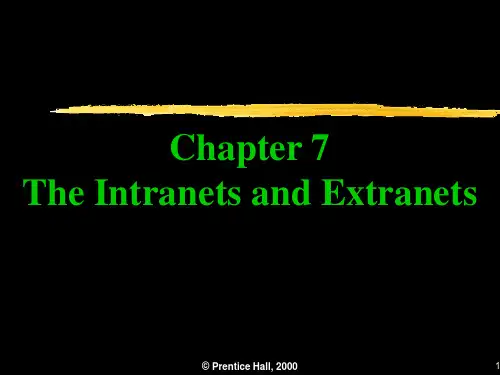
*
The Intranets
An intranet is a corporate LAN and/or Wide Area Network (WAN) that is secured behind company’s firewalls and it uses Internet technologies. Although intranets are developed using the same TCP/IP protocol as the Internet, they operate as private networks with limited access. Only employees who are issued passwords and access codes are able to use them. So, intranets are limited to information pertinent to the company and contain exclusive and often proprietary and sensitive information. Firewalls protect intranets from unauthorized outside access.
Identify the key element of extranets Identify the key technologies for tunneling Discuss the applications of extranets Describe typical industries that use extranets Discuss the business models for extranet applications Describe the concept of embedded extranets
电子商务导论重点
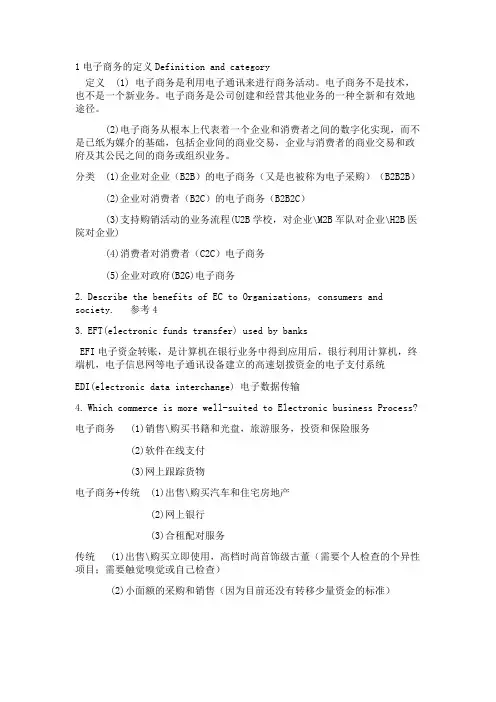
1电子商务的定义Definition and category定义 (1) 电子商务是利用电子通讯来进行商务活动。
电子商务不是技术,也不是一个新业务。
电子商务是公司创建和经营其他业务的一种全新和有效地途径。
(2)电子商务从根本上代表着一个企业和消费者之间的数字化实现,而不是已纸为媒介的基础,包括企业间的商业交易,企业与消费者的商业交易和政府及其公民之间的商务或组织业务。
分类 (1)企业对企业(B2B)的电子商务(又是也被称为电子采购)(B2B2B)(2)企业对消费者(B2C)的电子商务(B2B2C)(3)支持购销活动的业务流程(U2B学校,对企业\M2B军队对企业\H2B医院对企业)(4)消费者对消费者(C2C)电子商务(5)企业对政府(B2G)电子商务2.Describe the benefits of EC to Organizations, consumers and society. 参考43.EFT(electronic funds transfer) used by banksEFI电子资金转账,是计算机在银行业务中得到应用后,银行利用计算机,终端机,电子信息网等电子通讯设备建立的高速划拨资金的电子支付系统EDI(electronic data interchange) 电子数据传输4.Which commerce is more well-suited to Electronic business Process?电子商务 (1)销售\购买书籍和光盘,旅游服务,投资和保险服务(2)软件在线支付(3)网上跟踪货物电子商务+传统 (1)出售\购买汽车和住宅房地产(2)网上银行(3)合租配对服务传统 (1)出售\购买立即使用,高档时尚首饰级古董(需要个人检查的个异性项目;需要触觉嗅觉或自己检查)(2)小面额的采购和销售(因为目前还没有转移少量资金的标准)5.Advantages of E-Commerce?(1)增加销售,降低成本使得小企业获得全球客户群通过电子销售查询,报价和订单受理降低成本(2)为买家提供采购机会(企业可以找出新的供应商和合作伙伴)(3)增加信息交换的速度和准确性,从而降低成本(4)可以每天24小时处理业务(5)购买信息的详细程度由用户选择(6)数字化商品可以立即交付(7)在互联网上分发可以降低退税。
电子商务导论(双语) chap08

orders, and customers need protection against the
merchants’ unjustifiable denial of past payment
© Prentice Hall, 2000
6
Security Schemes
Secret Key Cryptography (symmetric)
it does not protect against all security hazards
it is mature, simple, and widely use
SET ( Secure Electronic Transaction) is a very comprehensive security protocol
© Prentice Hall, 2000
3
SSL Vs. SET: Who Will Win?
A part of SSL (Secure Socket Layer) is available on customers’ browsers
it is basically an encryption mechanism for order taking, queries and other applications
it may be abandoned if it is not simplified/improved
© Prentice Hall, 2000
4
Payments, Protocols and Related Issues
SET Protocol is for Credit Card Payments Electronic Cash and Micropayments Electronic Fund Transfer on the Internet Stored Value Cards and Electronic Cash Electronic Check Systems
电子商务双语目录
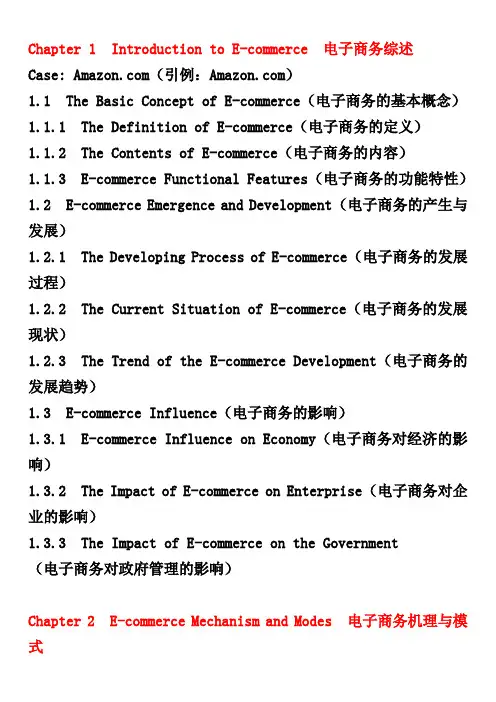
Chapter 1 Introduction to E-commerce 电子商务综述Case: (引例:)1.1 The Basic Concept of E-commerce(电子商务的基本概念)1.1.1 The Definition of E-commerce(电子商务的定义)1.1.2 The Contents of E-commerce(电子商务的内容)1.1.3 E-commerce Functional Features(电子商务的功能特性)1.2 E-commerce Emergence and Development(电子商务的产生与发展)1.2.1 The Developing Process of E-commerce(电子商务的发展过程)1.2.2 The Current Situation of E-commerce(电子商务的发展现状)1.2.3 The Trend of the E-commerce Development(电子商务的发展趋势)1.3 E-commerce Influence(电子商务的影响)1.3.1 E-commerce Influence on Economy(电子商务对经济的影响)1.3.2 The Impact of E-commerce on Enterprise(电子商务对企业的影响)1.3.3 The Impact of E-commerce on the Government(电子商务对政府管理的影响)Chapter 2 E-commerce Mechanism and Modes 电子商务机理与模式Case: Digital Beijing Project(引例:首都电子商务工程)2.1 Basic E-commerce Modes(电子商务的基本模式)2.1.1 B2B Mode(B2B模式)2.1.2 B2C Mode(B2C模式)2.1.3 B2G Mode(B2G模式)2.1.4 G2G Mode(G2G模式)2.1.5 C2C Mode(C2C模式)2.2 Framework of E-commerce(电子商务的结构)2.2.1 General Framework of E-commerce(电子商务总框架)2.2.2 Application Framework of E-commerce(电子商务的应用框架)2.3 Elements of E-commerce System(电子商务的系统组成)2.3.1 Major Elements of E-commerce System(电子商务系统的主要组成部分)2.3.2 Network Framework of E-commerce System(电子商务系统的网络架构)2.3.3 Applications Level of E-commerce System(电子商务系统的应用层次)Chapter 3 E-commerce Infrastructural Facilities 电子商务基础设施Case: Covad(引例:Covad)3.1 The Basis of Computer Network(计算机网络基础)3.1.1 Definition of Computer Network(计算机网络的定义)3.1.2 Computer Network Classification(计算机网络的分类)3.1.3 Function of Computer Network(计算机网络的功能)3.2 Network Communication Protocol(网络通信协议)3.2.1 OSI and IEEE 802 Protocol(OSI与IEEE 802协议)3.2.2 TCP/IP Protocol Suite(TCP/IP协议簇)3.2.3 WLAN Communication Protocol(WLAN通信协议)3.3 Internet(互联网)3.3.1 The Emergence and Development of Internet(互联网的产生与发展)3.3.2 Internet Application(互联网的主要应用)3.3.3 IP Address and Domain Name(IP地址和域名)3.3.4 Internet Access(互联网接入方式)3.3.5 Intranet, Extranet and Internet(内联网、外延网和互联网)3.4 Network Program Technology(网络编程技术)3.4.1 Markup Language(标识语言)3.4.2 Java(Java)3.4.3 .NET(.NET)Chapter 4 Information Processing Technology 信息处理技术Case: General Electric(引例:通用电气)4.1 Electronic Data Interchange(电子数据交换)4.1.1 Introduction of EDI(EDI概述)4.1.2 EDI Standards(EDI标准)4.1.3 EDI Network(EDI网络)4.2 RFID Technology(RFID技术)4.2.1 Brief Introduction to RFID(RFID技术简介)4.2.2 Contents of RFID Tracking System(RFID跟踪系统的组成)4.3 GPS Technology(GPS技术)4.3.1 Brief Introduction to GPS(GPS技术简介)4.3.2 Content of GPS Tracking System(GPS跟踪系统的组成)4.4 GIS Technologies(GIS技术)Chapter 5 E-commerce Payment Technology 电子商务支付技术Case: First Internet Bank of Indiana(引例:印第安纳第一网络银行)5.1 E-money(电子货币)5.1.1 Bank Cards(银行卡)5.1.2 E-cash(电子现金)5.1.3 E-check(电子支票)5.1.4 E-wallets(电子钱包)5.2 E-payment System(电子支付系统)5.2.1 E-cash Payment System(电子现金支付系统)5.2.2 Bank Card Payment System(银行卡支付系统)5.2.3 The E-check System(电子支票支付系统)5.3 Internet Technologies and the Banking Industry(互联网技术与银行业)5.3.1 E-bank(网上银行)5.3.2 Mobile Bank(移动银行)Chapter 6 E-commerce Security Technology 电子商务安全技术Case: Bibliofind Company(引例:Bibliofind Company)6.1 Introduction to E-commerce Security(电子商务安全概述)6.1.1 Security Issues in E-commerce(电子商务的安全性问题)6.1.2 The Basic Requirements for Security in E-commerce (EC对安全的基本要求)6.1.3 Measures for E-commerce Security(电子商务安全措施)6.2 Encryption Technology(加密技术)6.2.1 Basic Concept(基本概念)6.2.2 Symmetric Encryption Technology(对称式密钥加密技术)6.2.3 Asymmetric Encryption Technology(非对称密钥加密技术)6.2.4 Mixed EncryptionTechnology(混合加密技术)6.3 Authentication Technology(认证技术)6.3.1 Basic Concept(基本概念)6.3.2 Message Digest and Digital Signatures(数字摘要与数字签名)6.3.3 Digital Certificates and CA Security Authentication (数字证书与CA安全认证体系)6.3.4 Public Key Infrastructure(公钥基础设施)6.4 Firewall Technology(防火墙技术)6.4.1 Basic Concept of the Firewall(防火墙的基本概念)6.4.2 Firewall Principle(防火墙原理)6.4.3 Security Policy and Limitations of Firewall(防火墙的安全策略及局限性)6.5 Security Payment Technology(安全支付技术)6.5.1 Secure Socket Layer(安全套接层协议)6.5.2 Secure Electronic Transaction(安全电子交易协议)6.5.3 Comparison between SSL and SET(SSL与SET比较)Chapter 7 E-commerce and the Law 电子商务与法律Case: Legal Issue Related to Hyperlink on the Website(引例:关于网站中的超链接的法律问题)7.1 Introduction to E-commerce Law(电子商务法介绍)7.1.1 The Legal Issue for E-commerce(电子商务引发的法律问题)7.1.2 Concepts and Features of E-commerce Law(电子商务法的概念及其特征)7.1.3 The Legislation Course of E-commerce(电子商务立法进程)7.2 The Law Issues in E-commerce's Transactions(电子商务交易中存在的法律问题)7.2.1 Electronic Signature Law of the People's Republic of China(《中华人民共和国电子签名法》)7.2.2 Contracting and Contract Enforcement in E-commerce (电子商务中的合同和履行)7.2.3 Digital Signatures and Authentication(电子签名及认证问题)7.3 Intellectual Property in E-commerce(电子商务中的知识产权问题)7.3.1 Copyright(网络著作权的法律保护)7.3.2 Domain Names(有关域名的法律保护)7.3.3 Database(数据库的法律保护)7.4 Customer Right Protection at E-commerce(电子商务中的消费者权益保护)7.4.1 Customer Privacy Protection(消费者隐私权保护)7.4.2 Virtual Property Protection(虚拟财产的保护)Chapter 8 E-commerce and Taxation 电子商务与税收Case:eBay'ers(引例:eBay用户)8.1 Introduction to Taxation in E-commerce(电子商务税收概述)8.1.1 Taxation and Its Significance(税收及其重要性)8.1.2 Characteristics of E-commerce Taxation(电子商务税收的特点)8.2 Taxation Issue in E-commerce(电子商务带来的税收问题)8.2.1 Argument for E-commerce Taxation(电子商务征税的争执)8.2.2 Permanent Establishment(常设机构)8.2.3 Tax Jurisdiction(税收权限)8.3 International Legislation of E-commerce Taxation(国际上电子商务的税收法规)8.3.1 Two Perspectives Over Taxation Policy(电子商务税收政策的两种观点)8.3.2 Nexus(直接关系税)8.3.3 European Union Value Added Taxes(欧盟的增值税)8.3.4 The OECD Five Key Principles for E-commerce Taxation(经济发展与合作组织对于电子商务税收的5点原则)8.3.5 Alternative Ways of Taxing the E-commerc(对电子商务税收的几种方案)Chapter 9 E-commerce and Business Management企业电子商务管理Case:P&G and Wal-Mart(引例:宝洁和沃尔玛)9.1 Critical Success Factors and E-commerce Strategies (关键成功因素与电子商务策略)9.1.1 Critical Success Factors(关键成功因素)9.1.2 Critical Success Factors in E-commerce(电子商务的关键成功因素)9.2 E-commerce and Supply Chain Management(电子商务与供应链管理)9.2.1 Supply Chain Introduction(供应链介绍)9.2.2 E-supply Chain Management(电子商务供应链管理)9.2.3 Supply Chain Integration with the Application of E-commerce(运用电子商务进行供应链整合)9.3 E-commerce and Human Resources Management(电子商务与人力资源管理)9.3.1 HRM in the Context of E-Commerce(电子商务环境下的人力资源管理)9.3.2 Knowledge Management(知识管理)9.4 E-commerce and Logistics(电子商务与物流管理)9.4.1 E-logistics Management(电子商务物流管理)9.4.2 E-logistics Differs from Traditional Logistics(电子商务物流与传统物流的区别)Chapter 10 Construction of E-commerce System电子商务系统建设Case:Sinochem Corporation E-commerce System(引例:中国化工进出口总公司电子商务系统)10.1 System Design of E-commerce System(电子商务系统设计)10.1.1 Framework of E-commerce System(电子商务系统结构)10.1.2 E-commerce Website Design Elements(电子商务网站设计要素)10.2 The Developing Process of E-commerce System(电子商务系统建设过程)10.2.1 Lifecycle of System Development(系统开发周期)10.2.2 System Analysis and Planning(系统分析和规划)10.2.3 System Design and Development(系统设计与开发)10.2.4 System Testing/Implementation/Maintenance(系统测试/实施/维护)10.3 System Software of E-commerce System(电子商务系统的主要软件)10.3.1 Web Server Software(Web服务器软件)10.3.2 Application Server(应用服务器)10.3.3 E-commerce Software Package(电子商务软件包)Chapter 11 E-commerce Website 电子商务网站建设Case:Circuit City's E-superstore(引例:Circuit City的网上超市)11.1 E-commerce and Portal Site(电子商务和门户网站)11.1.1 Types of Portal Site(门户网站的类型)11.1.2 Importance of Web Portals(网络门户网站的重要性)11.2 Website Construction(网站建设)11.2.1 The Pattern of E-shops(网上商店的模式)11.2.2 Launch an Successful Online Business(启动一个成功的网上商业项目)11.2.3 Website Design(网站设计)11.2.4 Actualization of E-shops(网上商店的实现)11.3 E-shop Fore-end(网络商店前台)11.3.1 Online Catalog(网上产品目录)11.3.2 Shopping Cart(购物车)11.3.3 Online Payment(网上支付)11.4 E-shop Back-end(网络商店后台)11.4.1 Order Processing(订单处理)11.4.2 Customer Relationship Management(CRM)(客户关系管理)11.4.3 Logistics(物流配送)Chapter 12 E-commerce and the Latest Development电子商务发展动态Case:The Future Store in Germany(引例:德国的未来超市)12.1 Current Status of E-commerce(电子商务现状)12.1.1 Global E-commerce Latest Development(全球电子商务发展的基本情况)12.1.2 Development of E-commerce in China(中国电子商务的基本情况)12.1.3 Problems in China's E-commerce Development(中国电子商务发展中存在的问题)12.1.4 Policy for the Promotion of E-commerce Development (中国促进电子商务发展的方针政策)12.2 M-commerce(移动电子商务)12.2.1 Technologies of M-commerce(移动电子商务的实现技术)12.2.2 M-tickets(移动电子票务)12.3 Other E-commerce Development(其他电子商务的发展情况)12.3.1 IPTV(数字电视)12.3.2 Blog(博客)。
电子商务导论(双语)所划重点
电子商务导论(双语)所划重点1.Definition and category EC is the use of electronic communication to do business,the transfer of information,over internet.B2B,B2C,C2C,B2G,business processes that supply buying or selling activities(U2B,M2B,H2B),eg.DELLcomputer.2.Describe the benefits of EC to ORGANIZATIONS, CONSUMERS AND SOCIETYOrganizations:global reach/Cost reduction/supply chain improvement/new business model/rapid time-to-market/lower communication costs/improve costomer relation/no city business permits and fees.Consumer: ubiqulity(无处不在)/more products and services/cheeper products and services/instant delivery/information availabilities/no sales tax.Society:telecommuting/higher standard of living/availability of public services.3.EFT(Electronic Funds Transfer) used by banks:电子资金转账,银行业务中高速划拨资金的电子支付系统,如POS系统、ATM系统等。
电子商务重点整理
电⼦商务重点整理第⼀章电⼦商务导论1、电⼦商务(electronic commerce ,EC),就是利⽤计算机⽹络,主要是互联⽹和内联⽹买卖、交换、配送、服务、信息的过程。
2、电⼦业务(e-business),是电⼦商务的⼴义含义。
除了买、卖商品和服务外,还包括客户服务,与商业伙伴之间的协调、合作,利⽤⽹络开展学习活动,以及在机构内部进⾏的电⼦交易。
3、完全电⼦商务与部分电⼦商务(9个维度,图P5)按照数字化(指实体形式向数字形式的转换过程)程度的⾼低,电⼦商务可以有多种形式。
数字化包括:①订单系统数字化(订购、⽀付);②⽣产流程数字化(指产品/服务的制作);③配送⽅式数字化。
在完全电⼦商务模式中,3个维度都是数字的。
商务活动中只要有⼀个要素是数字的,我们就可以认为它属于电⼦商务,但是为“部分电⼦商务”。
4、电⼦商务活动开展(1)电⼦市场:买卖双⽅可以进⾏信息、产品、服务以及资⾦的交换的在线市场(2)跨组织信息系统(IOSs):允许在两个或更多组织之间进⾏⽇常交易处理与信息传递的通信系统(包含了在两个或是更多组织之间的交易过程和信息流)(3)组织内部信息系统:⽀持在独⽴组织内部进⾏电⼦商务活动的信息系统5、电⼦商务组织(EC organizations)(1)brick-and-mortar organizations(完全的实体组织/砖⽡灰浆式组织):主要业务是在实体世界中完成并且通过实体代理⼈销售实体产品的旧经济组织;(2)virtual (pure-play) organizations(虚拟组织/纯电⼦商务组织):所有业务均在⽹上开展;(3)click-and-mortar (click-and-brick) organizations(⿏标加⽔泥模式):该组织进⾏⼀些电⼦商务业务,但主要的业务还是在实体世界中完成。
6、电⼦商务的主体框架(电⼦商务依赖于五个独⽴领域)(1)People(⼈员):买家、卖家、中间商、信息系统及技术专家、其他各种员⼯及形形⾊⾊的参与者共同构成了⼀⼤⽀柱。
电子商务各章节复习重点内容
电子商务各章节复习重点内容第1章电子商务导论1. 电子商务的定义广义理解:电子商务是指在计算机通信网络基础上,利用电子工具实现商业交换和商业作业活动的全过程。
狭义理解:电子商务是利用TCP/IP公众网络和技术进行的在线交易和商业作业活动。
EC被称为狭义的电子商务;主要进行网上交易活动。
EB被称为广义的电子商务;包括对企业外部网和企业内部网的运用一个市场是由三部分组成的,即主体(代理)、产品和过程。
2.电子商务的分类按交易对象分类:B TO C、B TO B、其他对象间的电子商务,如B TO G、C TO C电子商务。
B TO B模式包括:买方采购;垂直社团;电子化市场按照电子商务所使用的网络类型分类:EDI电子商务;互联网电子商务内部网电子商务3. 电子商务的特性:普遍性、方便性、整体性、安全性、协调性4. 电子商务的影响:A电子商务改变商务活动的方式B电子商务改变人们的消费方式C电子商务将改变企业的生产方式D电子商务将给传统企业带来一场革命E电子商务将带来一个全新的金融业F电子商务将转变政府的行为5. 我国电子商务在发展过程中面临哪些问题?A网络基础设施建设问题B安全问题 C 网上支付问题D物流配送问题E电子商务法律问题F企业信息化水平落后问题G企业管理水平落后、经营方式陈旧问题H诚信问题6. 电子商务与传统商务的运作过程比较交易前的准备过程:传统商务:商品信息的发布、查询和匹配电子商务:通过网络,快速、高效率贸易磋商过程:传统商务:口头磋商,通过邮寄传递纸面贸易单证电子商务:电子化,专门的数据交换协议合同与执行过程:传统商务:合同书面形式,通过合同由相应机构仲裁电子商务:网络协议,电子商务应用系统支付过程:传统商务:支票和现金电子商务:信用卡、电子支票、电子现金、电子钱包7. 电子商务的功能:广告宣传、咨询洽谈、网上订购、网上支付(电子账户)、物流服务传递、意见征询、交易管理选择题及思考题第2,3,4,5,8 题第2章电子商务的商业模式1.商业模式的概念:一种包含了一系列要素及其关系的概念性工具,用以阐明某个特定实体的商业逻辑。
电子商务导论英文版第二版第01章
Learning Objectives
6. Describe some EC business models. 7. Describe the benefits of EC to organizations, consumers, and society. 8. Describe the limitations of EC. 9. Describe the contribution of EC to organizations responding to environmental pressures.
1-11
Electronic Commerce: Definitions and Concepts
Internet versus Non-Internet EC
Most EC is done over the Internet, but EC also can be conducted on private networks, such as value-added networks, local area networks, or on a single computerized machine Non-Internet EC includes the use of mobile handwriting-recognition computers used by field reps to write their notes in the field
1-7
Electronic Commerce: Definitions and Concepts
Pure versus Partial EC
EC can take several forms depending on the degree of digitization
- 1、下载文档前请自行甄别文档内容的完整性,平台不提供额外的编辑、内容补充、找答案等附加服务。
- 2、"仅部分预览"的文档,不可在线预览部分如存在完整性等问题,可反馈申请退款(可完整预览的文档不适用该条件!)。
- 3、如文档侵犯您的权益,请联系客服反馈,我们会尽快为您处理(人工客服工作时间:9:00-18:30)。
题型:1.单选题(2分x20=40分2多选题(3分x5=15分)3短语翻译(1分x15=15分)问答题(4分x5=20 分)分析题(10分x1=10分)Chapter 11.电子商务的定义和类别广义—指交易当事人或参与人利用以现代信息技术为基础的互联网所进行的各类商业活动;狭义—指交易当事人通过以因特网为主的计算机网络所实施的各种交易活动。
按交易类型:B2C、B2B、G2B;按商务活动内容:贸易型和服务性;根据使用网络类型不同:EDI商务、因特网商务、内联网商务、移动商务。
2.Describe the benefits of EC to ORGANIZATIONS, CONSUMERS AND SOCIETY3.EFT(Electronic Funds Transfer) used by banks电子资金转账”。
EFT是计算机在银行业务中得到应用后,银行利用计算机、终端机、电子信息网络等电子通讯设备建立的高速划拨资金的电子支付系统。
4.Which commerce is more well-suited to Business Process?⏹E-commerce电子商务⏹E-commerce + Traditional电子商务+传统⏹Traditional传统5.Advantages of E-Commerce.⏹Increases sales, decreases cost增加销售,减少成本⏹Provides purchasing opportunities for buyers 为买家提供采购机会(企业可以确定新的供应商和合作伙伴)⏹Increase speed and accuracy for exchanged information, thus reducing cost增加信息交换的速度和准确性,从而降低成本⏹Business can be transacted 24hrs a day可以一天24小时交易业务⏹The level of detail of purchase information is selected by user详细级别的购买信息由用户选定⏹Digital products can be delivered instantly数码产品可以立即交付⏹Tax refunds, public retirement and welfare support costs less when distributed over theInternet退税,公共退休和福利支持成本分布在互联网时少⏹Allows products and services to be available in remote areas, e.g. remote learning使产品和服务可在偏远地区,如远程学习6.电子商务国际化当中遇到的问题(文化为主)Culture – the combination of111language and customs文化,语言和风俗222Culture varies across national boundaries and in many cases regions within nations文化跨越国界不同,在许多情况下,区域内的国家333Choice of icons on Web pages becomes problematic on international Web sites:选择的图标在网页上就会有问题,在国际网站上:(In the US a shopping cart is useful, in the UK a shopping basket is more appropriate, Australians call shopping carts, shopping trolleysIn many places other than Brazil the thumbs up gesture means okay, in Brazil it is an obscene gesture在美国一个购物车是有用的,在英国购物篮子是更合适的,澳大利亚人叫购物车,购物手推车,在其他很多地方比巴西大拇指手势意味着好,在巴西是一个淫秽的姿势)7.交易成本transaction costTransaction costs are the total costs that a buyer and seller incur as they gather information and negotiate a purchase/sale transaction交易成本是总成本,买方和卖方承担收集信息和谈判购买/销售事务Transaction costs are the main reason for vertical integration (Ronald Coase)交易成本是垂直整合的主要原因(罗纳德•科斯)Businesses can use e-commerce to reduce transaction costs (e.g. telecommuting rather than physical commuting to allow global employment opportunities)企业可以利用电子商务来减少交易成本(如远程办公而不是物理通勤允许全球就业机会)CHAPTER 2WWW(World Wide Web)----> 定义及作用The world wide web (WWW) is a subset of the computers on the Internet that connect in a certain way, making their content accessible to each other万维网(WWW)是计算机在互联网上的一个子集,以某种方式连接,使其内容可访问The WWW includes an easy to use standard interface facilitating ease of useWWW包括一个易于使用的标准接口方便易用性电子邮件何时出现(in 1972)ISP (Information Service Provider)信息服务提供商Product-Switched Network(LAN/WAN)产品转换网络Four key rules used by ARPANETndependent networks (e.g. A LAN or WAN) should not require internal changes in order to be connected to the network独立的网络(如LAN或WAN)应该不需要内部的变化才能连接到网络Packets that do not arrive at their destination must be resent from their source network包,不到达目的地必须对源网络Router computers act only as receiving and forwarding devices; They do not retain information about the packets they handle路由器电脑才接收和转发设备;他们不保留他们的信息数据包处理No global control of the network exist没有全球控制网络的存在Differences between Internet & Extranet有一个Intranet和Internet之间的一个主要区别:互联网是一个开放的,公共空间,而内部网的设计是一个私人空间。
内部网可以从Internet访问,但作为一项规则它是由一个密码和访问只能给员工或其他授权用户的保护。
Low cost distribution of internal corporate information低成本企业内部信息的分布Based on client server model基于客户服务器模式Intranets use Web browsers, internet-based protocols including TCP/IP, FTP, Telnet, HTML and HTTP 内部网使用Web浏览器,网络协议包括TCP / IP、FTP、Telnet、HTML和HTTP Distributing paper is often more expensive分发纸通常更昂贵Intranets can also be used to provide software updates and patches, which update users computers automatically – using scripts内部网还可以用来提供软件更新和补丁,更新用户电脑自动——使用脚本+++++++++++++++++++++++++++++++++++++++++++++++++++++++++++++++ Networks that connect companies with suppliers, business partners and authorised users网络连接公司与供应商、商业伙伴和授权用户Each user has access to the databases, files and other information stored on computers connected to the extranet每个用户访问数据库,文件和其他信息存储在计算机连接到外联网Fedex changed from an Intranet to Extranet for package tracking on their Web site联邦快递从内部网、外部网改变包跟踪网站CHAPTER 3Revenue model(B2C & B2B)收入模式:Web catalog revenue model网上目录盈利模式Digital content revenue model数字内容盈利模式Advertising-supported revenue model广告支持的收入模式Advertising-subscription mixed revenue model广告订购混合收入模式Fee-based revenue models收费收入模式Web advertising problems (CPM/CPA)网络广告问题(CPM / CPA)1) Identifying ways to measure and charge for site visitors1)识别方法来衡量和收费站点访问者2) Few Web sites have sufficient visitors to attract large advertisers2)一些网站有足够的游客吸引广告商Web presence goals网络存在的目标实现网络的存在目标1)Attracting visitors to the Web site1)网站吸引访客2)Making the site interesting enough that visitors stay and explore2)使网站足够有趣,游客停留和探索3)Convincing visitors to follow the site’s links to obtain information3)说服游客遵守网站的链接获取信息4)Creating an impression consistent with the organizaiton’s desired image4)创建一个印象符合organizaiton所需的图像5)Building a trusting relationship with visitors5)建立信任与游客的关系6) Reinforcing positive images that the visitor might already have about the organization6)加强正面形象,游客可能已经组织7)Encouraging visitors to return to the site7)鼓励游客回到现场Web site Usability网站可用性CHAPTER 41.4P指的是PRICE/PRODUCT/ PROMOTION/ PLACE2.市场细分的种类(Geographic/demographic/psychographic /segmentation)地理/人口/ 心理/细分3.STRATEGYPRODUCT-BASED STRATEGY基于产品的营销策略CUSTOMER-BASED STRATEGY客户营销策略4.消费者忠诚度的五个阶段Awareness意识Exploration探索Familiarity熟悉Commitment承诺Separation分离漏斗模型This funnel model allows companies to determine which advertising and promotion strategies actually work这个漏斗模型允许公司确定哪些广告和促销策略的实际工作It is divided into three parts:它分为三个部分:Customer acquisition获取客户Customer conversion客户转换Customer retention客户保留广告成本的计量(trial visit repeat visit click through)??????????CHAPTER 5B2B key business drivers B2B关键业务驱动因素The availability of a secure broadband Internet platform and private and public B2B e-marketplaces; 一个安全的宽带互联网平台的可用性和私人和公共B2B电子市场;The need for collaborations between suppliers and buyers;需要供应商和买家之间的协作;The ability to save money, reduce delays, and improve collaboration; and省钱的能力,减少航班延误,提高协作;和The emergence of effective technologies for intra- and interorganizational integration.有效的技术的出现为内部和企业间的集成。
